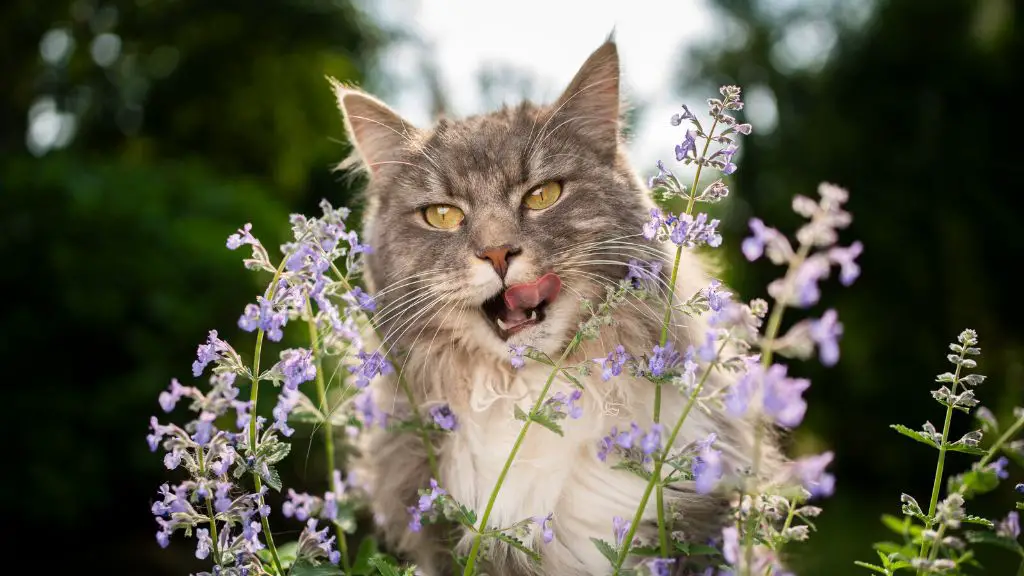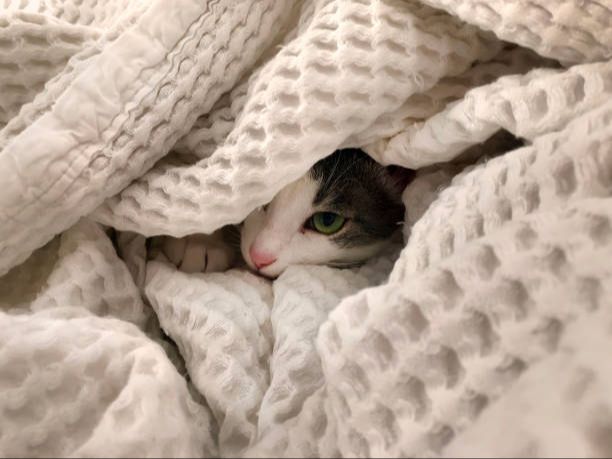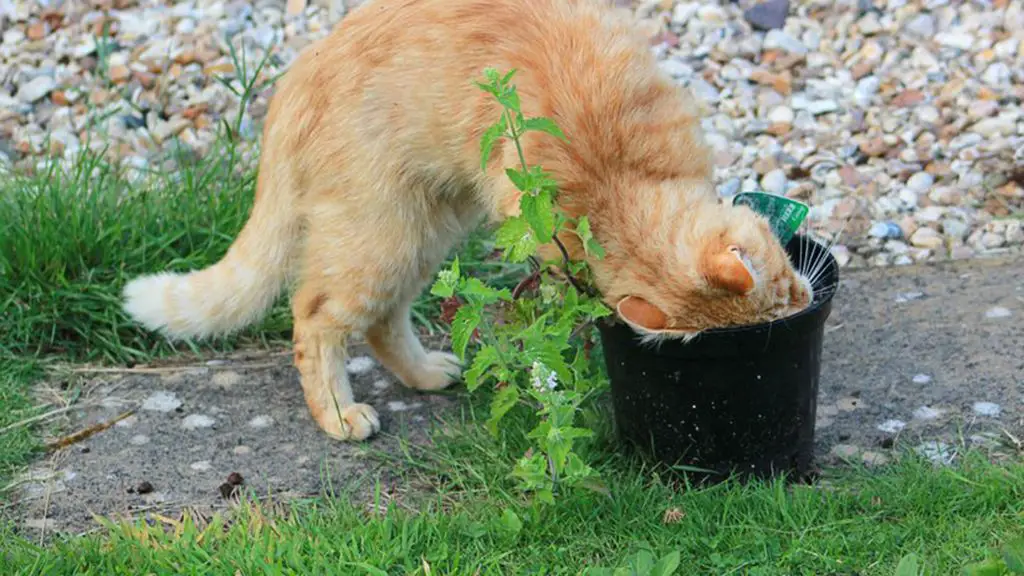What is Catnip and How Does it Affect Cats?
Catnip (botanical name Nepeta cataria) is a species of the mint family. It contains a compound called nepetalactone, which triggers a narcotic-like response in cats. When cats smell or ingest catnip, it binds to receptors in their brain and causes effects that are similar to those of recreational drugs in humans.
The response to catnip is inherited in domestic cats and is independent of gender or neutering status. Most domestic cats (around 70-80%) will respond to catnip to some degree.
Catnip exposure causes cats to show several behaviors including rolling, flipping, rubbing, and eventually zoning out. They may meow or growl at the same time. Other cats become hyperactive or overly aggressive when exposed to catnip. The effects of catnip last about 5-15 minutes before wearing off.
While the response to catnip is similar to a narcotic, it is harmless and non-addictive for cats. Consuming catnip does not produce ongoing euphoria in cats like addictive drugs do in humans.

Not All Cats are Attracted to Catnip
Many cat owners assume all cats love catnip, but that’s not actually true. Research shows only about 50-70% of cats respond positively to catnip (Purina, n.d.). This is due to genetics – there is a gene that determines sensitivity to the active compound in catnip called nepetalactone. If a cat lacks this gene, they will not have a reaction to catnip.
Kittens younger than 6 months old typically do not respond to catnip. The sensitivity seems to develop around 3-6 months of age. Before reaching this age, most kittens show no interest in catnip (The Dodo, 2022). Some senior cats who previously enjoyed catnip also lose interest as they get older.
So while many cats go crazy for catnip, around 30% do not react at all due to their genetics. Kittens need to reach a certain developmental stage before catnip sensitivity emerges.
Signs of Catnip Overdose
Too much catnip can cause unpleasant side effects in cats. The most common signs of catnip overdose include:
- Aggressive behavior like biting, scratching, and attacking objects or people
- Anxiety and restlessness, pacing or running around erratically
- Increased vocalization like meowing or yowling
- Hiding and over-grooming
According to veterinarians, these signs tend to appear within 5-15 minutes after a cat has too much catnip and can last 30 minutes or longer (source: https://www.petful.com/pet-health/can-cats-overdose-on-catnip/). The stimulant effects of the catnip plant are believed to cause this hyperactive, erratic behavior when consumed in large quantities.

In mild cases, the cat will return to normal after the catnip wears off. But in rare instances with very large amounts, it may require veterinary treatment to relieve the symptoms.
Causes of Catnip Overdose
There are a few main causes that can lead to cats overdosing on catnip:
Eating Large Amounts – Cats can experience overdose symptoms if they eat large quantities of catnip rather than just smelling it. The organic compounds that produce the high are absorbed faster through ingestion.
More Potent than Smelling – Eating catnip gives a more potent reaction than just smelling it. The intoxicating organic compounds are absorbed into the bloodstream when ingested, leading to a stronger high.
Access to Concentrated Catnip Oil – Pure, concentrated catnip oil can cause overdose symptoms in cats very quickly. The oil contains a high level of nepetalactone which causes the intoxicating effects.
In general, eating catnip gives a stronger reaction than smelling it. Access to very concentrated forms like oils increases the risk. Moderation is key, as large ingestion can cause an overdose.
Treating Catnip Overdose
The first step to treat catnip overdose is to remove all access to catnip. This will prevent the cat from ingesting more catnip and worsening the overdose. Put away or dispose of any catnip plants, toys, or treats. If the cat gets into outdoor plants, consider keeping them indoors until the effects subside.
It can also help to redirect the cat’s energy into positive playtime and exercise. Use interactive toys like feather wands, laser pointers, puzzle toys, and balls to keep them occupied. Play until the cat seems calm and relaxed. This can help take their mind off the catnip and reduce anxious or hyperactive behavior.

For cats experiencing anxiety or stress from catnip overdose, try to calmly comfort them. Pet them in their favorite spots, speak in soothing tones, and make sure they have access to hiding spots if needed. Creating a peaceful, familiar environment can help anxious cats relax.
If the cat has a severe reaction to catnip overdose, such as prolonged vomiting, diarrhea or lethargy, consult a veterinarian right away. They can provide supportive care and make sure there are no lasting effects from the overdose. In most cases, effects will subside within a few hours, but it’s still a good idea to call the vet for guidance.
Preventing Catnip Overdose
There are some simple steps cat owners can take to help prevent accidental catnip overdose:
Limit access and store catnip out of reach. Keep bags of dried catnip and catnip toys in a closed cabinet or closet so your cat can’t get into it when unattended. Only bring it out for supervised playtime.
Use catnip sparingly and offer toys not loose catnip. When giving your cat catnip, sprinkle a small amount on toys instead of offering piles of loose dried leaves. This helps control the dosage.
Avoid concentrated catnip oils. Oils have much higher concentrations of the active compound compared to dried leaves. It’s safer to stick to dried catnip.
Monitor multi-cat households. If you have multiple cats, keep an eye on their interactions with catnip to ensure one cat isn’t hogging all the toys and overindulging.
Moderation is key when it comes to catnip. Keeping it out of reach and using only small amounts can help prevent your cat from overdoing it.
Can Other Animals Get High on Catnip?
Besides domestic cats, catnip has been shown to affect larger wild cats like lions and tigers in much the same way. According to https://www.quora.com/Do-any-other-animals-respond-to-catnip-in-the-same-way-as-cats
, big cats like tigers and lions can become intoxicated by catnip. This is likely due to their shared feline biology with domestic cats. However, animals like dogs seem completely unaffected by catnip. According to https://a-z-animals.com/blog/why-do-cats-like-catnip/, this is because dogs lack the feline receptors responsible for the euphoric response triggered by catnip’s active chemical compound nepetalactone. While anecdotal accounts suggest animals like mice, rats, and even humans may show responses to catnip, there is no clear scientific evidence to prove these claims.
Uses of Catnip Beyond Recreational
While catnip is most well known for its intoxicating effects on cats, the herb has other uses beyond recreational. Catnip contains a chemical called nepetalactone which acts as a natural insect repellent. Many gardeners will plant catnip near vegetables and flowers to help repel pests like mosquitos, flies, and aphids. nepetalactone in catnip oil has been shown to be up to ten times more effective at repelling insects than DEET (1).
Catnip also has a long history of use in herbal medicine for humans. In folk remedies, catnip tea has been used to soothe upset stomachs, reduce fevers, and induce sleep (2). The relaxing properties of catnip have also led to its use in some commercial herbal teas. However, most human uses of catnip are based on anecdotal evidence rather than scientific study.
Overall, while recreational use of catnip by cats gets the most attention, the herb does have other documented uses as an insect repellant and in human herbal remedies.
Sources:
(1) https://gardeningknowhow.com/edible/herbs/catnip/uses-for-catnip-plants.htm

(2) https://drugs.com/npc/catnip.html
Potential Risks of Catnip for Cats
While catnip is generally considered safe for feline consumption and enjoyment, overindulgence can pose some risks for cats. The main potential risks of catnip include:
Overindulgence can cause vomiting or diarrhea. Consuming too much catnip can upset a cat’s digestive system and lead to vomiting or loose stools (Petcarerx). These symptoms are temporary and resolve on their own as the catnip leaves their system.
Aggressive play may cause injuries. Under the influence of catnip, some cats become more active and aggressive in their play. This rambunctious behavior can potentially lead to minor injuries like scratches or strained muscles (ASPCA). Supervising play sessions can help prevent injuries.
Interactions with medications unknown. Little research exists on how catnip may interact with veterinary medications or treatments. It’s best to consult your vet before giving catnip to a cat on medication (ASPCA).
Overall, catnip is very safe for cats when given in moderation. Monitoring your cat’s consumption, providing supervision during play, and speaking with your vet can help minimize potential risks.
Moderation is Key
Occasional recreational use of catnip is generally considered safe for most cats according to sources like The Do’s and Don’ts of Catnip. However, as with any substance, moderation is important. Cat owners should monitor their cat’s catnip intake and avoid allowing overdoses.
Considering the cat’s age, health conditions, and sensitivity to catnip is also advised. Catnip may not be suitable for very young kittens or cats with certain medical issues. When used responsibly in moderation as an enriching treat, catnip can provide cats with positive stimulation.

